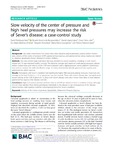Mostrar o rexistro simple do ítem
Slow velocity of the center of pressure and high heel pressures may increase the risk of Sever’s disease: a case-control study
| dc.contributor.author | Rodríguez Sanz, David | |
| dc.contributor.author | Becerro-de-Bengoa-Vallejo, Ricardo | |
| dc.contributor.author | López-López, Daniel | |
| dc.contributor.author | Calvo-Lobo, César | |
| dc.contributor.author | Martínez-Jiménez, Eva María | |
| dc.contributor.author | Pérez-Boal, Eduardo | |
| dc.contributor.author | Losa Iglesias, Marta Elena | |
| dc.contributor.author | Palomo-López, Patricia | |
| dc.date.accessioned | 2022-03-22T11:41:00Z | |
| dc.date.available | 2022-03-22T11:41:00Z | |
| dc.date.issued | 2018-11 | |
| dc.identifier.citation | Rodríguez-Sanz, D., Becerro-de-Bengoa-Vallejo, R., López-López, D. et al. Slow velocity of the center of pressure and high heel pressures may increase the risk of Sever’s disease: a case-control study. BMC Pediatr 18, 357 (2018). https://doi.org/10.1186/s12887-018-1318-1 | es_ES |
| dc.identifier.uri | http://hdl.handle.net/2183/30126 | |
| dc.description.abstract | [Abstract] Abstract Background: This study determined if the body mass index, dynamic plantar-pressures, plantar surface contactarea, velocity of the centre of pressure (COP), gastrocnemius equinus, and gastrocnemius soleus equines are related to calcaneal apophysitis (Sever’s disease) in athletic children. Methods: This case-control study examined 106 boys enrolled in a soccer academy, including 53 with Sever’s disease and 53 age-matched healthy controls. The dynamic average and maximum peak plantar-pressures, plantar surface contact-area, and velocity of the COP were evaluated with a digital pressure sensor platform. Goniometry was used to measure the ankle dorsiflexion range of motion and thereby identify gastrocnemius equinus and gastrocnemius soleus equinus. Results: Participants with Sever’s condition had significantly higher BMI and peak plantar-pressures (maximum and average) at the heel (Cohen’s d > 3 for pressures) than the controls. Those with Sever’s disease also had significantly slower velocity of the COP (Cohen’s d > 3). Boys with Sever’s disease were also 8 times more likely to have bilateral gastrocnemius equinus than disease controls. Conclusions: High heel plantar pressure and low velocity of COP are related to Sever’s condition in boys, although it is not clear whether these factors predispose individuals to the disease or are consequences of the disease. Gastrocnemius ankle equinus could be a predisposing factor for Sever’s condition. | es_ES |
| dc.language.iso | eng | es_ES |
| dc.publisher | BMC | es_ES |
| dc.relation.uri | https://doi.org/10.1186/s12887-018-1318-1 | es_ES |
| dc.rights | Atribución 3.0 España | es_ES |
| dc.rights.uri | http://creativecommons.org/licenses/by/3.0/es/ | * |
| dc.subject | Velocity of the centre of pressure | es_ES |
| dc.subject | Rapidez del centro de presión | es_ES |
| dc.subject | Apophysitis | es_ES |
| dc.subject | Apofisitis | es_ES |
| dc.subject | Adolescents | es_ES |
| dc.subject | Adolescentes | es_ES |
| dc.subject | Pressure | es_ES |
| dc.subject | Presión | es_ES |
| dc.subject | Equinus | es_ES |
| dc.subject | Equin | es_ES |
| dc.title | Slow velocity of the center of pressure and high heel pressures may increase the risk of Sever’s disease: a case-control study | es_ES |
| dc.type | info:eu-repo/semantics/article | es_ES |
| dc.rights.access | info:eu-repo/semantics/openAccess | es_ES |
| UDC.journalTitle | BMC Pediatrics | es_ES |
| UDC.volume | 18 | es_ES |
| UDC.startPage | 357 | es_ES |
Ficheiros no ítem
Este ítem aparece na(s) seguinte(s) colección(s)
-
GI-UDISAP - Artigos [193]






